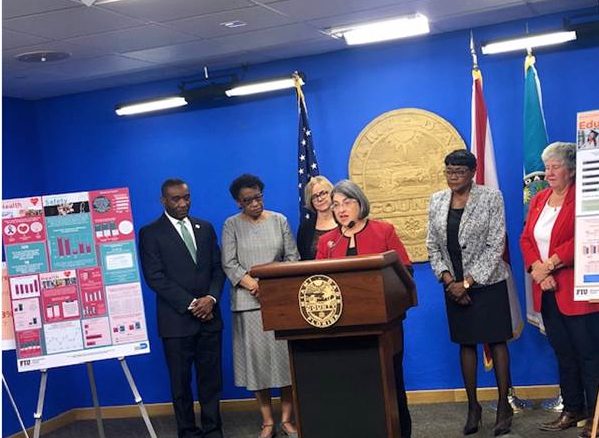
The Miami Dade Board of County Commissioners, the Commission Auditor and Florida International University’s Metropolitan Center on Mar. 19 announced the release of the third annual report on the status of women in Miami-Dade County.
The report’s findings shed light on areas in which women and girls are succeeding or struggling, particularly in economic opportunity, education and health.
The report, authored by the FIU Metropolitan Center’s Dr. Maria Ilcheva, is a result of legislation sponsored by Commissioner Daniella Levine Cava. In 2015, the county commission adopted the UN Convention on the Elimination of all Forms of Discrimination Against Women (CEDAW). The ordinance requires a report to be produced each year, providing a benchmark for measuring gender equity in the county.
While it has been 56 years since the federal Equal Pay Act was signed into law, women’s pay still lags behind men’s. The 2019 report shows that the wage disparity in Miami-Dade has not changed much in the past decade, with women making about 86 cents to a $1 a man earns.
Some key findings in the report include:
Educational attainment
• More women earn bachelor’s degrees (19.8%) and fewer attain graduate or professional degrees (10%); 17.8% of men have bachelor’s degrees and 11% have graduate or professional degrees.
• In 2017, the largest proportion of bachelor’s degrees attained by women in the 25-39 age group were in science, engineering and related fields; 44.8%, up from 39.1% in 2016.
Economic participation
• Although women are the majority of the population in Miami-Dade, they only represent 44.2% of the full-time workforce.
Economic equality
• In a decade, the gap between men’s and women’s earnings increased from 13.9% in 2007 to 14.2% in 2017.
• In 2017, the earnings gap for full-time female workers decreased to 14% down from 15% in 2016.
• There are double-digit gaps in the top 10 highest-paid occupations for women.
• When adjusted for inflation, both women’s and men’s earnings have declined over the past 10 years.
• The earnings of White, non-Hispanic full-time workers were 42% higher than those of Black workers, and 37% higher than Hispanic workers.
“Despite the fact that more women than ever are graduating from colleges and universities, an unacceptable wage gap persists,” Commissioner Levine Cava said. “It is our hope that by sharing this crucial report with the community, we can all join in crafting common-sense solutions that will further improve the lives of women and girls in Miami-Dade County.”
Since adoption of the CEDAW ordinance, the commission has passed several pieces of legislation addressing pay equity for women in county contracts, representation of women on county boards, and updates to the county’s sexual harassment policies.
The Miami-Dade Commission for Women took the lead on identifying policy priorities which informed the legislative agenda and is working to prepare policy recommendations based on the 2019 report.
“With the help of my colleagues on the Board of County Commissioners, I look forward to reviewing and implementing these recommendations to address inequalities that still exist between men and women,” Miami-Dade County Commission chair Audrey M. Edmonson said. “As we celebrate Women’s History Month, let’s commit ourselves to truly valuing and supporting women, because when women do well, our society does well.”
For a copy of the report contact County Commissioner Levine Cava at District8@miamidade.gov or 305-378-6677.







Comments are closed.